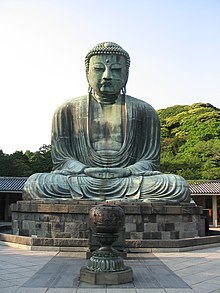Kamakura time
The Kamakura period ( Japanese 鎌倉 時代 , Kamakura jidai ; 1185–1333) is an epoch in Japanese history . It got its name from the then seat of government of the Shogun in Kamakura . It marks the rise of the warrior nobility compared to the court nobility in Kyoto , which still dominated in the Heian period .
prehistory
Since around 1150, power in Japan was in fact in the hands of the monastery emperors (院 政, insei ), officially abdicated regents who left the incumbent Tennō , i.e. their sons, only representative tasks. This resulted in clashes between rival families of the high nobility.
Overall, the control of the central power over the individual provinces became weaker and weaker during this time, when the great warrior families ( samurai ) were increasingly fighting for supremacy in Japan: above all the Taira and the Minamoto , the most powerful families in the 12th century. In 1160 the Heiji Rebellion broke out , a violent clash between the Taira and the Minamoto. Minamoto no Yoshitomo , the head of the Minamoto clan, was killed during the fighting . The result was that power passed to the sword nobility. The Taira were finally defeated by the Minamoto on July 25, 1185 in the naval battle of Dan-no-ura during the Gempei War .
From then on, many high posts were held by members of the Minamoto family. The trade, especially with the China of the Song Dynasty , was promoted again, and there were built new ports. To maintain the loyalty of the provinces, fiefs and rights of use were given to the princes.
Establishment of the Shogunate
Minamoto no Yoritomo (1147-1199) one of the sons of the head of the Minamoto, received the hereditary title of Seii Taishogun from the Tennō in 1192 because of his military achievements and took over the affairs of government in Kamakura . He did not destroy the existing system, but overlaid it with military elements. The administration ran through his headquarters in Kamakura, and power now rests solely with the warrior families, the bushi . Yoritomo was accepted early on by the Hōjō and married Hōjō Masako, the daughter of Hōjō Tokimasa . Yoritomo died in 1199, after which the power of the Hōjō rose. After a conflict with the imperial court, the imperial troops were destroyed by the Hōjō under the leadership of Hōjō Tokimasa. A new time of inner peace began. Behind the scenes, the Hōjō decided the imperial hierarchy.
In 1264 the Mongols under Kublai Khan conquered China and also demanded the submission of Japan. But the Bakufu refused and ignored the threats.
In the years 1274 and 1281, the shoguns in northwest Kyūshū fought off two invasion attempts by the Mongols . Twice the Mongolian fleet built by Koreans was destroyed by typhoons . According to legend, these winds were from the gods ( Kami sent), hence the name Kamikaze ( gods wind ), but the second storm is only called Kamikaze. The samurai demanded a reward for their service, which, however, could not or only to a small extent be granted by the shogunate, since in the defense of the country there was no gain from land conquest or spoils of war. In addition, many sects of Buddhism demanded donations because they based the kamikaze on their reading of sutras. After the Mongol invasions, the island kingdom of Japan was never again to be attacked by a foreign power until the Pacific War in the 20th century.
In their displeasure, the Ashikaga and Nitta families in particular turned more to the emperor. This finally took advantage of the Tennō Go-Daigo to overthrow the Hōjō shogunate in 1333 and begin a restoration of imperial power. The so-called Kemmu restoration only lasted a few years, mainly due to the different interests of Go-Daigo and the Ashikaga. The Ashikaga seized power and installed their own emperor. Go-Daigo then built a new residence south of the capital Kyoto. The court was split into a northern (Kyōto) and southern (Yoshino) court (the time of the north and south courts ). Go-Daigo could only survive by the large samurai families that stood behind him. The Ashikaga head was made Shogun, whom even China recognized as King of Japan. The Ashikaga reopened trading with the Chinese imperial court. In 1392 the conflict between the southern and northern emperors ended with Go-Kameyamas , Go-Daigo's great-grandson, renouncing his claims to power.
religion
In the Kamakura period, popular preachers appeared who had a new understanding of Buddhism. The teaching was simplified and was thus not only accessible to the nobility, but also to the common people. Five monks from the Tendai School deserve special mention:
- Eisai ( 1141 - 1215 ) as the founder of the Rinzai-shū ,
- Dōgen ( 1200 - 1253 ) as the founder of the Sōtō-shū ,
- Hōnen ( 1133 - 1212 ) as the founder of the Jōdo-shū ,
- Shinran ( 1173 - 1262 ) as the founder of Jōdo Shinshū and
- Nichiren ( 1222 - 1282 ) as the founder of the Nichiren-shū .
List of Shoguns
- Minamoto no Yoritomo (1147–1199, r. 1192–1199)
- Minamoto no Yoriie (1182–1204, r. 1202–1203)
- Minamoto no Sanetomo (1192–1219, r. 1203–1219)
- Kujō Yoritsune (1218–1256, r. 1226–1244)
- Kujō Yoritsugu (1239–1256, r. 1244–1252)
- Prince Munetaka (1242–1274, r. 1252–1266)
- Prince Koreyasu (1264–1326, r. 1266–1289)
- Prince Hisaaki (1276-1328, r. 1289-1308)
- Prince Morikuni (1301-1333, r. 1308-1333)
Individual evidence
- ↑ The Origin of the Kamakura Shôgunate. Retrieved November 3, 2015 .
